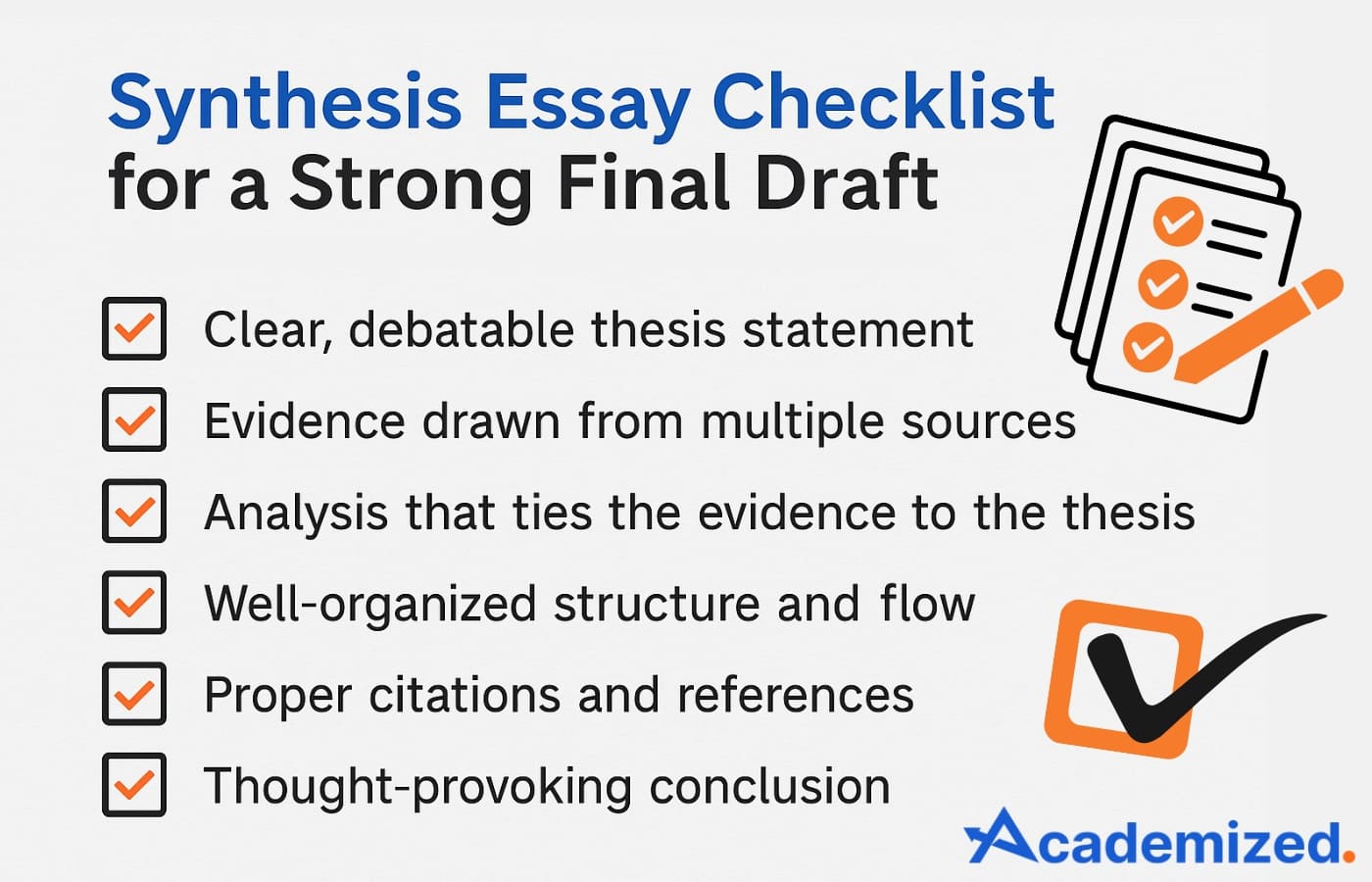- Blog
- How to Write a Synthesis Essay (Step-by-Step Guide for Students)
How to Write a Synthesis Essay (Step-by-Step Guide for Students)
 Mary Watson
Mary Watson

Curious about how to write a synthesis essay that actually works? To write a strong and clear paper, combine multiple sources into a single, straightforward argument. A synthesis essay isn’t just a summary – it’s a combination of ideas, viewpoints, and facts that you weave into a well-supported discussion.
We’ve helped thousands of students confidently tackle synthesis essays, and here’s the truth: the key is balance. You need to show that you can analyze different sources, find connections, and use them to support a central point. Whether writing for an assignment or preparing for an AP test, knowing how to blend evidence and commentary effectively will set your work apart.
In this guide, we’ll walk you through the process step by step, offering tips and tools to help make your writing more effective and less stressful. Let’s break it down together!
What Exactly Is a Synthesis Essay
A synthesis essay is a type of writing that combines information from different sources to build a clear, focused argument or explanation. Instead of just summarizing each source, you draw connections between ideas and use them to support a central point. The goal is to show how these various pieces of information relate to each other and how they help answer a bigger question or support your position. It’s about blending ideas, not just collecting them.
Types of Synthesis Essays You Should Know
Synthesis essays can take different forms, depending on the purpose of the assignment. Some focus on argument, others on explanation. Understanding the kind you're asked to write helps you approach it correctly.
- Argument synthesis – This is the most common type. You’ll use information from sources to take a clear position on an issue and back it up with evidence. The focus is on persuading the reader.
- Explanatory synthesis – Instead of arguing a point, you explain how different sources contribute to a broader understanding of a topic. It’s more about informing than persuading.
- Review synthesis – Often used in academic research, this type gathers and compares existing studies or discussions to show trends or gaps.
Professional Guidelines on How to Write a Synthesis Essay
Writing a synthesis essay might seem complex, but it becomes much more manageable with the proper structure. Here’s how you should approach this process.
Step 1: Make Sense of the Sources
Before you start writing, you need to know what your sources are stating. Don’t just skim through them; read each one closely and look for key ideas, facts, or arguments. Ask yourself how each source connects to your topic and whether it agrees or disagrees with the others. It's not just about quoting – it's about seeing the bigger picture. Once you get a sense of how the pieces fit together, your main argument will come into focus.
Step 2: Plan Your Essay Writing
Once your sources are clear and your understanding of them is solid, it’s time to shift your focus to planning. A well-thought-out plan is essential for staying on track and building a strong argument. If you're wondering how to write a synthesis paper that flows and makes sense, this stage sets the foundation. With a focused idea, organized notes, and the right structure, your writing will become much easier to manage.
Pinpoint the Main Theme or Argument
Start by looking at your sources again and asking yourself what they have in common. What idea connects them? What larger point can you make by putting these ideas together? Your central theme should be specific enough to focus your essay, but broad enough to include multiple sources. Don’t try to cover too much; choose a clear angle that gives you space to explore, compare, and support your points.
Put Your Notes In Order
After you’ve found your main idea, go back to your notes and group related points together. Look for quotes, facts, or claims that support each part of your argument. Match sources with the role they’ll play in your essay – some might back up your position, while others might provide a counterpoint.
Determine Your Synthesis Essay Structure
Your structure depends on your goal, but most synthesis essays follow one of these common formats:
- Point-by-point – Each paragraph covers one aspect of the topic and compares how different sources address it. This works well for argument synthesis.
- Source-based – Each section focuses on a single source, then ties it back to your main idea. This can be helpful if your sources are complex or very different.
- Thematic – This method organizes information by themes or ideas across several sources. It’s handy for explanatory synthesis essays.
When it comes to structuring the sections of your paper, the basic essay structure, like the one below, works well for this type of academic paper:
Introduction
- Say what the topic is
- Give a little background
- End with your main point (thesis)
Body Paragraphs
- Start each paragraph with one clear idea
- Use facts or quotes from sources
- Explain how they support your point
Conclusion
- Remind the reader of your main point
- Quickly go over your main ideas
- End with one final thought
Come Up With a Synthesis Essay Outline for Your Paper
Before writing your synthesis essay, it’s helpful to create a clear outline. An essay outline is a simple plan that shows what you’ll write in each section of your paper. It keeps your ideas organized, helps you stay on track, and ensures your argument flows smoothly. Outlining before you start writing saves time and makes the final draft much stronger. Here’s a basic outline template you can use.
Introduction
- Hook – Start with an engaging fact, question, or quote related to the topic.
- Brief background – Explain the issue and why it matters.
- Thesis statement – Clearly state your main argument or central idea that connects the sources.
Body Paragraph 1
- Topic sentence – Introduce the first key point.
- Evidence from Source 1 – Include a quote or paraphrase.
- Evidence from Source 2 (if needed) – Show another perspective or example.
- Analysis – Explain how the evidence supports your point and ties back to your thesis.
Body Paragraph 2
- Topic sentence – Present the second supporting idea.
- Evidence from Source 3 – Add new support or contrast.
- Analysis – Explain the relationship between this idea and your argument.
Body Paragraph 3 (Optional – Counterargument or Additional Support)
- Topic sentence – Introduce a counterpoint or additional insight.
- Evidence – Use a source that challenges or deepens your position.
- Rebuttal or explanation – Respond to the counterpoint or expand the discussion.
Conclusion
- Restate your thesis – Use different words to rephrase your main idea.
- Summarize key points – Briefly review your strongest points.
- Final thought – End with a broader reflection, insight, or call to action.
Mind the Synthesis Essay Format Requirements
Below are the most common academic formatting standards for synthesis essays. That said, it is best to consult your academic advisor to see if your educational institution has any specific requirements you need to follow.
- Font: Times New Roman, 12-point
- Spacing: Double-spaced throughout the entire paper
- Margins: 1 inch on all sides
- Indentation: The first line of each paragraph should be indented 0.5 inches
- Title: Centered, same font/size, no bold or underline
- MLA: Your last name + page number in the top right corner
- APA: Page number only in the top right corner
- Use MLA or APA, depending on your assignment
- Include in-text citations for all paraphrased or quoted material
- Add a Works Cited (MLA) or References (APA) page at the end
Would you like to consult an expert regarding these and other requirements for a synthesis paper? Our essay writers are always ready to share their expertise!
Step 3: Write a Strong Thesis Statement
Your thesis is the focus of your entire essay, so it needs to be direct and specific. It’s not just a summary of the topic; it’s your main point, backed by how you’ve connected ideas across multiple sources. When writing a thesis for a synthesis essay, make sure it clearly shows your stance or main conclusion and hints at how your supporting points will develop. Avoid vague language, and aim to make your message easy to understand at a glance. A good thesis helps guide your reader and keeps your argument on track.
Step 4: Write a Catchy Synthesis Essay Introduction
A strong introduction grabs attention and sets up your argument. Start with a short background on the issue, then explain why it matters. Introduce the sources or perspectives you’ll be working with, but don’t dive into too much detail yet. The goal here is to ease the reader into the topic and lead naturally to your thesis at the end of the paragraph. Keep it focused and avoid going off-topic before the body paragraphs begin.
Read More: Best Ways to Start an Essay
Sentence Starters for Synthesis with Examples
Starting sentences smoothly will make your synthesis essay more readable and easier to follow. Good sentence openers help link ideas, show comparisons, or introduce evidence. Here are some practical examples you can use in your essay:
- One point that several sources agree on is…
- This idea is supported by the fact that…
- Another perspective to consider is…
- While one source claims that…, another argues…
- This contrast reveals that…
- The evidence suggests that…
- When comparing these views, it becomes clear that…
- A common theme among the sources is…
- These findings highlight the importance of…
- Based on this information, we can conclude that…
Step 5: Write Effective Synthesis Essay Body Paragraphs
Once the introduction and thesis are set, your main task is to build strong, well-supported body paragraphs. Each one should focus on a single point tied to your thesis and supported by evidence from your sources. Start with a clear topic sentence, then show how different sources connect to the idea you’re discussing. Make sure you explain the significance of the evidence, not just present it. Transitions between paragraphs matter; they help your reader follow your argument step by step. One of our top tips for writing a synthesis essay body section is to stay focused. Don’t try to cover everything at once. Keep each paragraph clear and organized around one main idea.
Step 6: Write the Concise Synthesis Essay Conclusion
The conclusion should bring your essay to a thoughtful close without repeating things word for word. Summarize the main ideas, but more importantly, show what those ideas mean together. This is your chance to highlight the bigger picture, explaining why your argument matters, what it reveals, or how it connects to larger issues. A good conclusion reinforces your thesis and leaves the reader with something to think about, rather than just restating earlier points. Keep it concise and impactful.
Read More: Tips on How to Write a Conclusion for an Essay
An Expert-Written Synthesis Essay Example
To better understand how all the parts of a synthesis essay come together, it helps to see a complete example. Below is a sample essay that combines multiple sources to form a clear, well-supported argument. It follows a basic structure and shows how source material can strengthen each point.
Topic: Should Social Media Platforms Be Responsible for Monitoring Misinformation?
Thesis: While social media companies should not control all content, they do have a responsibility to reduce the spread of misinformation that can harm public safety and democratic processes.
In today’s digital world, more people are getting their news from social media than ever before. This shift raises serious concerns about false information spreading quickly and widely. Some argue that platforms like Facebook and Twitter should be held responsible for what appears on their sites, while others believe that monitoring content violates free speech. The reality lies somewhere in the middle. Platforms should not control every message, but they do need to take action when content spreads lies that affect public health, elections, or safety.
A 2020 study by the Pew Research Center found that nearly half of U.S. adults get their news from social media. This gives platforms incredible influence over public opinion. When false claims are left unchecked, the results can be dangerous. During the COVID-19 pandemic, for example, misinformation about vaccines and treatments spread quickly online, leading to confusion and mistrust. According to the World Health Organization, the "infodemic" made it harder to control the virus because many people doubted official health advice. In this case, a lack of action from social media platforms put lives at risk.
On the other hand, critics say too much control by these companies can limit freedom of expression. The First Amendment protects speech in the U.S., and many worry that allowing private companies to decide what’s true and what isn’t could lead to censorship. While this concern is valid, it overlooks one key point: social media companies are private businesses, not government bodies. They already have rules for content, like removing hate speech or violent threats, so applying similar standards to false medical or political information isn’t a major leap.
Another important issue is how algorithms decide what users see. According to a report by the MIT Technology Review, social media algorithms often push sensational or misleading posts because they attract more clicks and engagement. That means the platforms aren’t just hosting misinformation but helping it spread. Adjusting these systems to favor trustworthy sources and flag questionable content could slow the damage without silencing voices.
In conclusion, social media platforms have the right to allow a wide range of views, but they also have a duty to step in when misinformation causes real harm. By improving their content policies and making their algorithms more responsible, these companies can protect free expression while still acting in the public interest. The balance is not easy, but it's one we must expect from platforms that shape how millions understand the world.
Do you want to get a custom top grading essay without any fuss, in just a few hours? Go to academized.com and order an affordable paper on any topic!
These Mistakes Can Hinder Your Synthesis Essay
Even with a strong plan, it’s easy to slip up while writing a synthesis essay. Knowing what to avoid can help keep your work on track and your message clear. Below are some of the most frequent mistakes students make and why they matter.
- Summarizing sources instead of connecting them – A synthesis essay isn’t just a collection of summaries. You need to show how ideas from different texts interact and support your point.
- Forgetting the thesis – Every part of your essay should tie back to your main idea. If your argument isn’t clear, the whole essay can feel unfocused.
- Using quotes with no explanation – Quoting a source isn’t enough. Always explain why it’s important and how it supports your argument.
- Lacking transitions – Without smooth transitions, your ideas may feel disconnected. Link your points clearly so your reader can follow your logic.
- Overloading one source – Relying too heavily on one source weakens your synthesis. Balance your references to show a range of views.
Test Your Paper Against This Synthesis Essay Checklist
If you’re unsure how to write a good synthesis essay, a quick checklist can help. These are the key things every well-written synthesis essay should include.

How to Meet AP and College-Level Essay Expectations
Whether you're writing for an AP exam or a college assignment, your audience will have expectations. Knowing what they value can help you write more effectively and avoid losing points for things that are easy to fix.
- Clear thesis statement – Readers want to see your position early and know exactly what your essay will focus on.
- Relevant, balanced sources – They expect a variety of sources to be used and evaluated fairly.
- Strong structure – Your ideas should be easy to follow, with logical paragraph order and transitions that guide the reader.
- Original thinking – Simply repeating source material isn’t enough. Your analysis and insights should show your understanding of the topic.
- Accurate citations – Proper formatting and attribution matter. Don’t lose marks over sloppy referencing.
- Polished writing – Clear grammar, punctuation, and spelling show care and help your message come through.
Need help with a different project? Our write my research paper service employs many experts in various fields.
Concluding Thoughts and Author's Tips for Writing a Perfect Synthesis Paper
As someone who’s written and reviewed countless student essays, I can confidently say that synthesis essays are more rewarding than they first appear. The challenge isn’t just in combining sources – it’s in showing how those sources work together to support your perspective. Early in my writing career, I used to approach these essays like long summaries. But the turning point came when I started applying synthesis essay techniques in writing that focused on comparison, contrast, and connection. That shift made a huge difference.
One piece of advice I always give students: don’t be afraid to question the sources you’re working with. When I started pushing back on ideas rather than simply accepting them, my writing became more thoughtful and stronger overall. Another trick that’s helped me and the students I coach is to map everything out before jumping into the draft. It sounds basic, but a rough outline keeps the logic clear and avoids repetitive points.
Synthesis essays push you to think critically and write clearly. They’re not just an academic exercise – they help you learn how to deal with complex information in real life, too. Whether you’re preparing for an AP test or writing for a class, stick with it. The more you practice, the easier it gets.
FAQ
What format should I follow for a synthesis essay?
A standard synthesis paper follows the typical essay format: introduction with a thesis, body paragraphs with evidence and commentary, and a conclusion. APA or MLA citation style may be required, depending on the assignment.
Do I need to use direct quotes in a synthesis essay?
You can include quotes, but they should support your points, not replace them. Paraphrasing is also useful. Always explain how the quote or reference ties into your argument.
What’s the best way to end a synthesis essay?
Your conclusion should briefly restate your main idea and highlight the importance of your argument. Example:
In connecting these viewpoints, it becomes clear that responsible technology use requires both individual awareness and broader industry accountability.
Am I allowed to use “I” in a synthesis essay?
Unless your teacher or prompt says otherwise, it’s best to avoid first-person in academic synthesis essays. Focus on the ideas, sources, and argument rather than your personal opinions.

Mary, our exceptional editor and online tutor, brings a wealth of knowledge to the table. With her extensive expertise in academic writing, she guides and mentors aspiring students, providing them with constructive feedback that propels their essays to the next level.


 Mary Watson
Mary Watson

